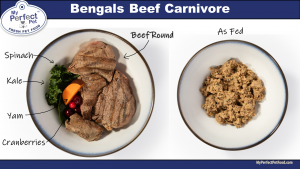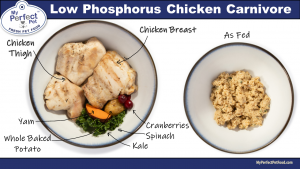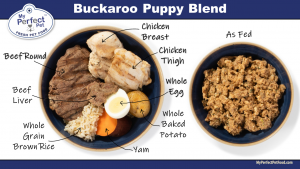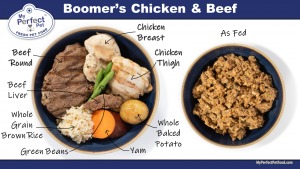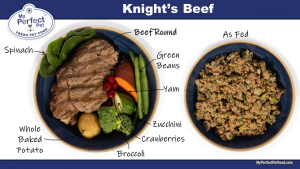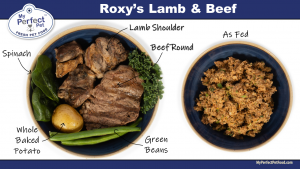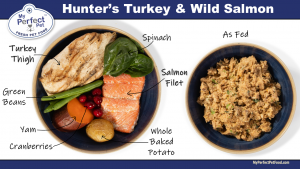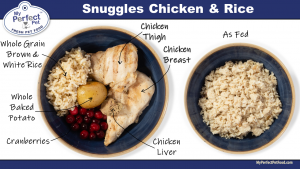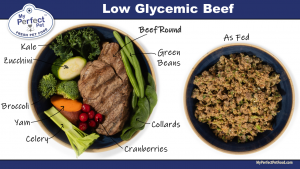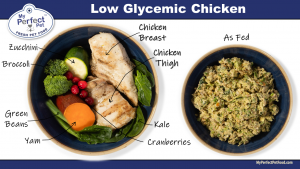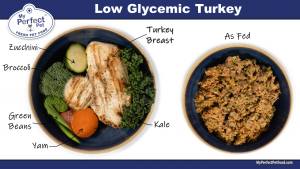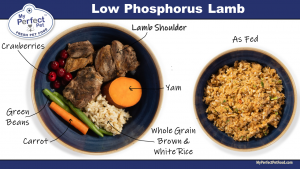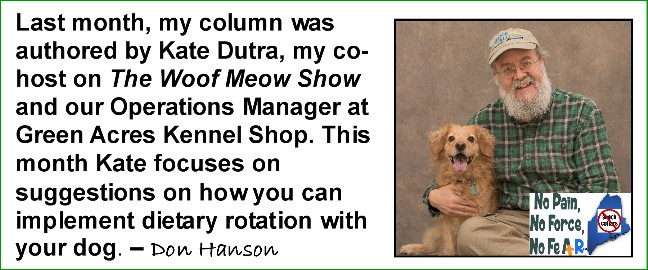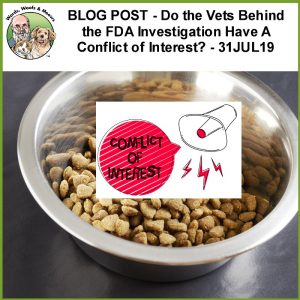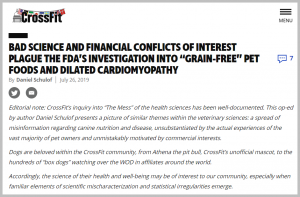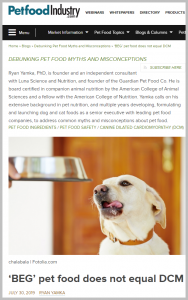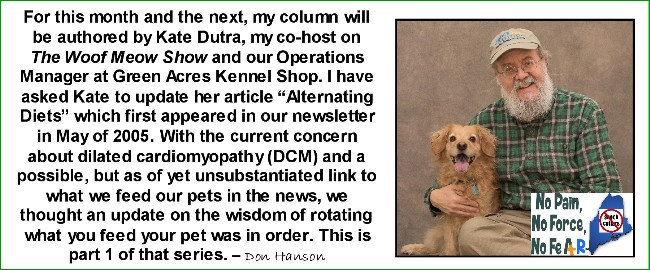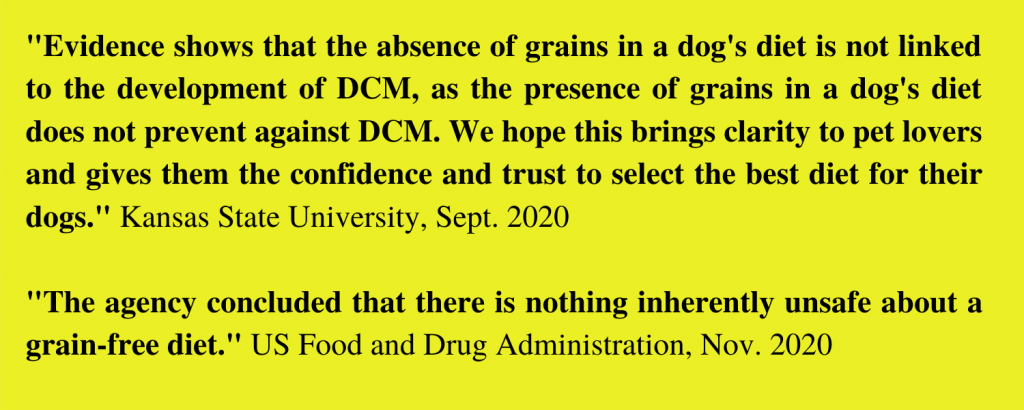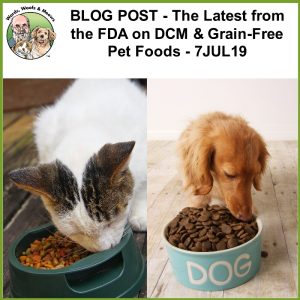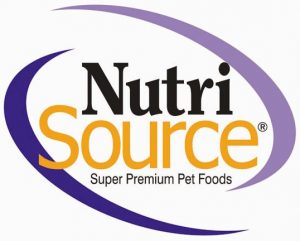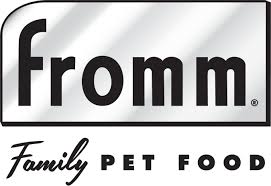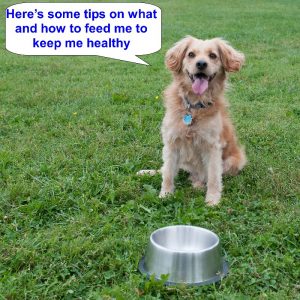Caveat Emptor – Buyer Beware
< A version of this article was published in the October 2019 issue of Downeast Dog News>
< A short link to this page – http://bit.ly/PetFoodComp >
As a pet food retailer, I am part of an industry that many believe; myself included, has a well-deserved reputation for being deceptive. Many companies  practice “legal’ marketing practices that any well-informed consumer would find intentionally unsettling. Some of the schemes used in the pet food industry make me hang my head in shame. I try to make up for that by learning everything I can and providing people with the information they need to feed their pets for optimal health. [ http://bit.ly/GAKS_Nut_Phil ]
practice “legal’ marketing practices that any well-informed consumer would find intentionally unsettling. Some of the schemes used in the pet food industry make me hang my head in shame. I try to make up for that by learning everything I can and providing people with the information they need to feed their pets for optimal health. [ http://bit.ly/GAKS_Nut_Phil ]
In her book Dog Food Logic: Making Smart Decisions for Your Dog in an Age of Too Many Choices, author and animal nutritionist Linda Case states. “We find that more than 50 % of dog owners do not distinguish between the brand name of a food and the company that produces (owns) that brand. This confusion is not the fault of owners, by any means, since it is in the best interest of large companies to keep consumers in the dark regarding exactly how many brands of food they produce and market.” I believe that if you want to do the best for your pet, this is information you need to know — caveat emptor.
Before you even consider specific brands of food, it is essential that you understand the companies behind the pet food industry.
Pet food is big business. According to data provided by Petfood Industry magazine, pet food companies had revenues of over $44 billion in 2018 for North America alone. Six companies, accounting for 106 different pet food 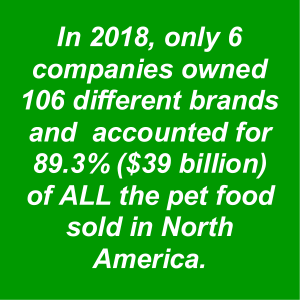 brands took in over $39 billion or 89.3% of all pet food revenue. It is essential to understand that all of those different brands you see advertised and see on retail shelves may not be as different as they would have you believe.
brands took in over $39 billion or 89.3% of all pet food revenue. It is essential to understand that all of those different brands you see advertised and see on retail shelves may not be as different as they would have you believe.
Leading the list of multi-national conglomerates in the pet food business is Mars Petcare, part of the Mars Candy company. Mars accounted for 41.08% of all the pet food sold in North America across their 41 pet care brands. Brands owned by Mars include; Cesar, Dreamies, Eukanuba, IAMS, Nutro, Pedigree, Royal Canin, Royal Canin Veterinary Diets, Sheba, Temptations, Waltham, and Whiskas.
Mars also owns the following corporate veterinary practices, which I find equally alarming. They include Banfield Pet Hospitals, bluepearl, Linnaeus, and petpartners. I don’t know about you, but I find the thought of a pet food company owning a chain of veterinary clinics and hospitals akin to a drug company owning medical clinics and hospitals; the antithesis of what is beneficial to health and a consumers finances.
Sometimes these conglomerates find the best way to deal with a competitor is to buy them and shut them down. In 2014, Mars purchased IAMS, Eukanuba, and Natura brands (California Natural, Evo, Healthwise, and Innova) for $2.9 billion. The Natura brands were, decent foods, but today they no longer exist thanks to Mars.
Nestlé Purina PetCare claimed the second position and 29.98% of pet food revenues across their 30 brands. Pet food and treat brands owned by Nestlé include: Alpo, Bakers, Beggin’, Beneful, Beyond, Busy, Castor & Pollux, Cat Chow, Chef Michael’s, Deli-Cat, Dog Chow, Fancy Feast, Felix, Friskies, Frosty Paws, Gourmet, Just Right, Kit & Kaboodle, Mighty Dog, Moist & Meaty, Muse, Purina, Purina ONE, Purina Pro Plan, Pro Plan Veterinary Diets, Second Nature, T-Bonz, Waggin’ Train, and Zukes.
Like Mars, Nestlé has also entered the veterinary practice market with its investment in Independent Vetcare Group International. How would you react if the primary source of food you buy for your family was also trying to control where you seek healthcare for your children?
At the third position on the list is J.M Smuckers, the jam company. They are relatively new to the pet care industry, having purchased several companies over the past few years. They are a food company but not known for producing food that is good for you. They control 6.6% of the pet food market in North America with 14 brands accounting for $2.9 billion in sales in 2018. Pet food and treat brands owned by Smucker’s include: 9 Lives, Canine Carry-Outs, Dad’s, Gravy Train, Kibble ‘n Bits, Meaty Bone, Meow Mix, Milk-Bone, Milo’s Kitchen, Natural Balance (Dick Van Patten), Nature’s Recipe, Pup-Peroni, Rachael Ray Nutrish, and Snausages.
Colgate-Palmolive, the toothpaste and dish soap conglomerate, owns Hill’s Pet Nutrition, also known as Science Diet, and is number 4 on the list. They control almost 5.3% of the North American market with four brands, accounting for $2.3 billion in sales for 2018. Their brands include; Science Diet, Prescription Diet, Ideal Balance, and Healthy Advantage.
Number five on the list is Diamond Pet Foods who makes their own food but is primarily this high on the list because they are a co-packer and manufacture food for a wide variety of other companies. They account for 3.4% of the North American Market with $1.5 billion in sales for 2018. Brands owned by Diamond include Diamond, Diamond Naturals, Diamond Naturals Grain-Free, Diamond Care, Nutra-Gold, Nutra-Gold Grain-Free, Nutra Nuggets Global, Nutra Nuggets US, Premium Edge, Professional, and Taste of the Wild. Brands made for other companies were not disclosed.
Last on our list is General Mills, best known for brands like Cheerios, Pillsbury, and Betty Crocker. Primarily a processed food company, not known for fresh, healthy food, General Mills entered the pet food business in 2018 with the purchase of Blue Buffalo. That gives them almost 3% of the North American market with $1.3 billion in sales for 2018. Blue Buffalo currently has six brands: Life Protection, Freedom, Basics, Wilderness, Carnivora, and Natural Veterinary Diet. Blue Buffalo is probably best known for television commercials that claim they include specific quality ingredients in their food and never use certain low-quality ingredients. Blue Buffalo has faced several lawsuits over these claims and in one was required to pay $32 million for false advertising, as Blue Buffalo pet food did include lower quality ingredients they claimed were not found in their products
You might think, well I eat food from all of these big companies and feed it to my children. What’s the harm in feeding it to my pet? The difference is that you probably consume a tiny percentage of food made by Mars, Nestlé, Smuckers and General Mills, and it is not your primary source of nutrition. In many cases a pet’s entire diet may come from one of these companies.
| Top 6 Pet Food Companies in North America – 2018 |
2018 SALES |
|
|
| COMPANY |
(million USD) |
% TOTAL |
# BRANDS |
| Mars Petcare Inc. |
18,085.00 |
41.08% |
41 |
| Nestlé Purina PetCare |
13,200.00 |
29.98% |
30 |
| J.M. Smucker |
2,900.00 |
6.59% |
14 |
| Hill’s Pet Nutrition |
2,318.00 |
5.26% |
4 |
| Diamond Pet Foods |
1,500.00 |
3.41% |
12 |
| General Mills (Blue Buffalo) |
1,300.00 |
2.95% |
5 |
| Top 6 Pet Food Companies in North America – 2018 |
2018 SALES |
|
| COMPANY |
(million USD) |
% TOTAL |
| Mars Petcare Inc. |
18,085.00 |
41.08% |
| Nestlé Purina PetCare |
13,200.00 |
29.98% |
| J.M. Smucker |
2,900.00 |
6.59% |
| Hill’s Pet Nutrition |
2,318.00 |
5.26% |
| Diamond Pet Foods |
1,500.00 |
3.41% |
| General Mills (Blue Buffalo) |
1,300.00 |
2.95% |
| Everyone Else |
4,725.20 |
10.73% |
| TOTAL |
44,028.20 |
100.00% |
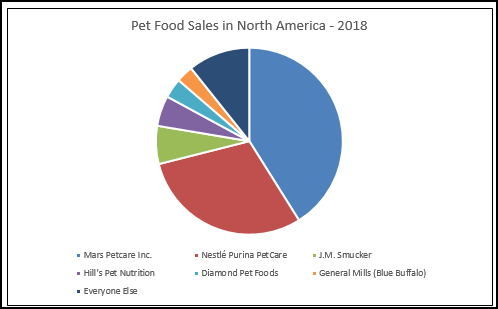
Recommended Resources
Green Acres Pet Nutrition Resources Page – http://bit.ly/GAKS_Nut_Home
GAKS Philosophy on Pet Nutrition – http://bit.ly/GAKS_Nut_Phil
Pet Foods We Offer At Green Acres Kennel Shop – http://bit.ly/GAKS_PetFood_Brands
Things I Wish I Had Known… The Importance of What I Feed My Pets – http://bit.ly/Things-Nutrition-1
Pet Nutrition: Some Myths and Facts – Part 1 – My story with Gus – Maine Dog Magazine – Winter 2017 – http://bit.ly/Gus-Nutrition
Pet Nutrition – What Should I Feed My Pet? – http://bit.ly/What-Should-I-Feed-My-Pet
Pet Nutrition – What Do You Feed Your Dog? – WWM-JUN2016 – http://bit.ly/WhatDoYouFeedYourDog
Pet Nutrition – Should I Feed My Pet A Raw Diet? – http://bit.ly/ShouldIFeedMyPetARawDiet
Pet Nutrition – The Science and Dogma of Pet Nutrition with Dr. Richard Patton with link to 1 hour video – http://bit.ly/Video-Dr-Richard-Patton
Podcast – Pet Nutrition with Dr. Richard Patton – http://bit.ly/DrPatton-Podcast
Podcast – Pet Fooled – A Look Inside A Questionable Industry with Kohl Harrington – http://bit.ly/WfMw-Pet-Fooled
Pet Nutrition – Why Rotating Diets Makes Sense – http://bit.ly/DietRotation
Pet Nutrition – The Wisdom of Rotating Your Pets Diet – Part 1 – http://bit.ly/DietRotation1-30JUL19
Pet Nutrition – The Wisdom of Rotating Your Pets Diet – Part 2 – http://bit.ly/DietRotation2
Shared News Story – An Exposé on Prescription Diets from WJLA ABC7 News – http://bit.ly/Nut-RXDiets-WJLA-24MAY19
FDA Update on Heart Disease in Dogs & What Should You Do? – 7JUL19 – http://bit.ly/FDA-DCM-Food-7JUL19
Shared Articles – More on the FDA, DCM and Pet Food – 10JUL19 – http://bit.ly/FDA-DCM-Food-10JUL19
Shared Articles – Do the Vets Behind the FDA Investigation Have A Conflict of Interest? –http://bit.ly/DCM-FDA-Conflict
Podcast – Is Feeding A Grain-Free Food to Our Dogs Dangerous?, with Linda Case, MS – http://bit.ly/Podcast-FDA-Grain-Free-LindaCase-29SEP18
Podcast – Pet Nutrition with Kymythy Schultze Author of Natural Nutrition for Cats: The Path to Purrfect Health – http://bit.ly/KymythySchultzeCatNutrition-Podcast
Podcast – An Eastern Approach to Pet Nutrition with Dr. Michael Munzer from All Creatures Acupuncture – http://bit.ly/WfMw-Munzer-EstrnNut-2018
Podcasts – Interview with Steve Brown about Unlocking the Canine Ancestral Diet – http://bit.ly/WfMw-SteveBrown-2010
Podcast – DCM, the FDA, and Dog Food-the Science and the Hype with Canine Nutritionist Linda Case – http://bit.ly/Blog-DCM-FDA-8AUG19
Podcast – Pet’s in the News–No. 4 Pet Food, DCM and The FDA – http://bit.ly/WfMw-DCM-FDA-20JUL19
Other Online Resources
Pet Fooled on Facebook – https://www.facebook.com/petfooled/
Pet Fooled Webpage – https://www.petfooled.com/pet-fooled-part-1.html
Wysong – The Truth About Pets Foods PDF – http://bit.ly/WysongTheTruthAboutPetFoods-pdf
________________________________________________________________________
Don Hanson is the co-owner of the Green Acres Kennel Shop ( greenacreskennel.com ) in Bangor, ME where he has been helping people with their pets since 1995. He is a Bach Foundation Registered Animal Practitioner (BFRAP), Certified Dog Behavior Consultant (CDBC), Associate Certified Cat Behavior Consultant (ACCBC) and a Certified Professional Dog Trainer (CPDT-KA). Don is a member of the Pet Professional Guild (PPG) and is committed to PPG’s Guiding Principles and the Pain-Free, Force-Free, and Fear-Free training, management, and care of all pets. Don produces and co-hosts a weekly radio show and podcast, The Woof Meow Show, that airs on Z62 Retro Radio WZON (AM620) and WKIT 103.3-HD3 and is streamed at http://bit.ly/AM620-WZON every Saturday at 9 AM. Podcasts of the show are available at http://woofmeowshow.libsyn.com/, the Apple Podcast app, and at Don’s blog: www.words-woofs-meows.com. The opinions in this post are those of Don Hanson.
©1OCT19, Donald J. Hanson, All Rights Reserved
< Click for Copyright and Use Policy >
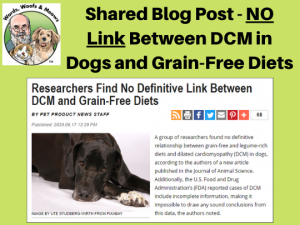
 some of the Green Acres staff pets as well as some clients who volunteered to give it a try. As a result of that process, we knew the My Perfect Pet blends and the company and people behind My Perfect Pet represented the type of product we wanted to offer to you. In a recent press release, Green Acres co-owner, Don Hanson stated:
some of the Green Acres staff pets as well as some clients who volunteered to give it a try. As a result of that process, we knew the My Perfect Pet blends and the company and people behind My Perfect Pet represented the type of product we wanted to offer to you. In a recent press release, Green Acres co-owner, Don Hanson stated: